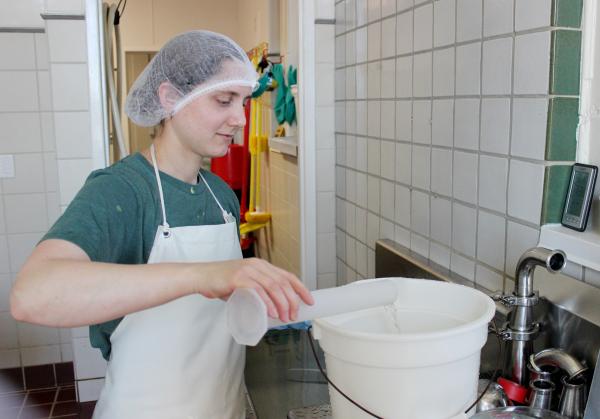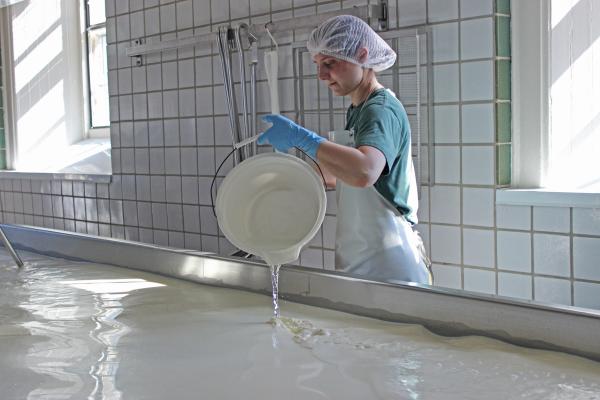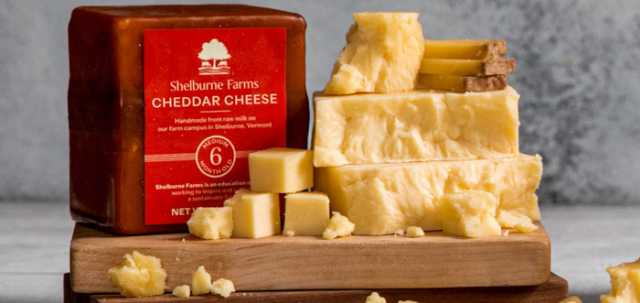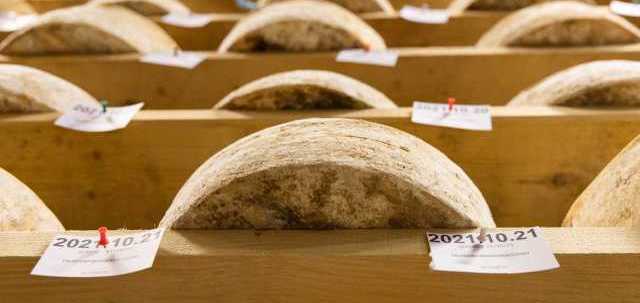My 7 year old and I learned about rennet while reading Little House in the Big Woods recently, and I have been wanting to know more about rennet at Shelburne Farms. Thanks so much for this informative article!
We all know the main ingredient in cheese is milk (and we spend a lot of our time talking about it), but what else is in cheese? Most cheeses are comprised of milk, salt, cultures and rennet. Rennet is the most fascinating of these ingredients, yet it is a mystery to many.
Although the origins of cheesemaking are murky and still much debated, one of my favorite “origin tales” is that of the nomadic shepherd who was traveling with milk in a sack made from the stomach of a young animal. Upon arriving at his destination, the shepherd went to take a swig of milk only to find that it had curdled into a delicious solid. While this is probably just a fable, it still speaks to a huge discovery in the science of cheesemaking! Something magical happens to milk in the stomachs of young ruminants that helps cheesemakers achieve our primary objective: to extend milk’s “shelf life”. Rennet is the magic!
But first, a little science primer. Milk is an emulsion of fat, protein, sugar and minerals suspended in water. Cheesemakers use one of a few different methods to trigger a chemical reaction that causes coagulation, transforming liquid milk into a solid coagulum, or curd. Coagulation occurs when proteins clump together, trapping fat and other solids like a sponge. For cheddar, a hard aged cheese, we use enzymatic coagulation--by adding rennet. For more on other methods of coagulation, check out this great article on Cheese Science Toolkit
Phew! Now that some of the chemistry is out of the way, what exactly is rennet? And where did it come from? Rennet is the general name for enzymes that act on proteins in milk. It’s purpose in a ruminant’s stomach is to curdle milk for easier digestion, the same way it curdled our shepherd’s drink. Rennet serves the same purpose in cheesemaking: it triggers coagulation.
There are several types of rennet. At Shelburne Farms, we utilize traditional calf rennet. Calf rennet contains two enzymes, chymosin and pepsin, in a natural ratio that is suitable for our style of cheese. (Chymosin causes coagulation, pepsin has impacts on the aging process.) This traditional rennet has more reliable results in yield, as well as flavor profile, leading to less defective cheese. It is also a natural and non-GMO option that exemplifies our efforts to be sustainable by utilizing all parts of the animal.
In some cultures, vegetable and plant rennet has been used to coagulate milk. In India, where the cow is revered for religious reasons, fruit trees were used. Many Spanish sheeps’ milk cheeses use thistle and cardoon rennets. One drawback of these coagulants is they may lead to bitter and undesirable flavors in cows’ milk cheeses.
A demand for an inexpensive and reliable alternative to calf rennet led to the development of a genetically modified bacterium that can produce rennet enzymes through fermentation, called fermentation produced chymosin. In 1990, Pfizer successfully produced a chymosin that is genetically identical to the chymosin found in calf rennet. It is filtered from the bacteria in which it’s grown and isolated. Fermentation produced chymosin does not contain pepsin, so for our purposes, it does not have the exact same impact on the aging process.
Calf rennet is now the only rennet we use here as it is best for the flavor profile we are seeking. We have used fermentation produced chymosin at Shelburne Farms in the past, and we believe the product is safe and reliable, and can be part of a healthy food system. Debate on whether these enzymes are effectively a genetically modified organism is ongoing. As of 2008, according to the culture houses who produce these products, 80-90 percent of cheeses in the United States and Britain utilize fermentation-produced chymosin. At the same time, it has been banned in several countries that do not allow genetic engineering of food products.
I hope this introduction to rennet helps to demystify this important cheese ingredient. As with all our food choices, understanding how a product is made can help us make more informed decisions. Still, the world of rennet is particularly complicated, both scientifically and chemically, and it raises important questions around food system health. For small cheese makers in Vermont, the choice of which rennet to use is not a simple one.
If you want to dive even deeper into this topic, check out the entry on “rennet” in the Oxford Companion to Cheese, edited by UVM professor Catherine Donnelly, with a forward by Jasper Hill Farm founder Mateo Kehler. UVM professor Paul Kindstedt has written two definitive books on cheese that cover rennet at length, American Farmstead Cheese and Cheese and Culture. (You can find copies at our Welcome Center and Farm Store.)
More about Cheese
Comments
I too am reading Little House in the Big Woods and remember my Grandmother referring to rennet. I just got the 75th anniversary addition for my 75th. Perhaps I am paying more attention. Thank You For this information.
Can you help? my daughter is convinced all cheddar cheese is vegetarian. I understand the cheese making process and the use of rennet(animal product). Cows milk is the main constituent of cheddar cheese and it is the primary ingredient. Is rennet part of the cheese making process and is therefore not an ingredient. Nobody list rennet as an ingredient on there packaging. But it is obviously used. This surely would create a cheese that is not vegetarian. Is it not listed as it is part of the process and not an ingredient.
Kindest Regards
Anthony A Sparsis
Cambridge
I hope you have your answer by now but here’s my (non-expert) opinion just in case and for others to read.
One of the most common forms of vegetarianism allows for consumption of dairy products like cheese but not any animal product derived from the slaughter of the animal. Rennet comes from calf stomach so, in such cases, cheese made with rennet would not be suitable for vegetarian diets. Now, if you are not that strict, you might argue that the rennet used to make cheese is relatively small and that no slaughter occurs to get the rennet - the slaughter is to make veal and the rennet is a “by-product” of that slaughter. So, cheese being vegetarian (if your form of vegetarianism includes dairy) is a bit about how strict you wish to be and what your motivations for being vegetarian are. Rennet makes the milk used to make cheese clump up into curds. Rennet is (for cheese making purposes) two enzymes, chymosin and bovine pepsin. There may be nothing left of them by the time you are eating your cheese but that does not matter to the animal who provided the rennet. Again, your motivation for being vegetarian will help guide whether the presence or absence of rennet in the cheese matters to you. Now, you can use chymosin that is made from non-animal sources and, in fact, over 80% of cheese consumed in North America is made from non-animal sources. Many cheese makers want the bovine pepsin enzyme for cheddar cheeses, especially aged cheddars, I think, so they use the calf-derived rennet. You may see the source of the rennet used in your cheese on the package. It may say something like Mucor miehei or microbial rennet or fermented rennet. If it does then you should have some confidence that the cheese is suitable for dairy-eating vegetarians. In my perfect future, veal production ceases to exist and therefore so does the calf rennet. I definitely don’t eat veal and try to stick to cheeses without calf rennet. The cheese situation is by far the less important of the two and much more complex so, while I still avoid it, I don’t lose too much sleep over the occasional chunk of aged cheddar in my mouth.
I want to make Limburger cheese your article says the cultured rennet doesn’t contain pepsin do I need that’s calf rennet or can I use the cultured rennet without pepsin
Thanks on details regarding cheese production. There have been many things done in either improving products or making them more healthy. Is there cheese more ideal for diabetics for example? What are its benefits and how is it's taste compared to the best ordinary cheese?
Hi,
I am very interested in the art of chesse making, but I can't find any course or school that teaches it. I would appreciate some suggestions from professionals like you because everything I have seen so far is homemade cheese video.
Thank you for your time
Love your article on rennet. I have a couple questions. The book "Eating to Extinction The World's Rarest Foods and Why We Need to Save Them" says "Half of all the world’s cheese is made with bacteria or enzymes made by one company." It also says "Ninety-five percent of milk consumed in the United States comes from a single breed of cow." Is that true? Thank you!
Above, it states that the whey is drained off. Do you dispose of it, and if so, would it be possible for me to come up and pick up a bucket full from time to time? I understand that it makes a fabulous spray fungicide in an orchard, and I would love to try it on my fruit trees and vegetables that are prone to powdery mildew.
Hi Barb, Thanks for your questions. We use the whey from cheesemaking as fertilizer on our fields. It's piped to an underground holding tank that sits across the road from the Farm Barn. Each month, we pump the whey into a tank on a tractor to spread it on our fields.
While the idea of using whey as a fungicide is fascinating, unfortunately, we cannot share our whey with the public due to food safety regulations. Sorry we can't be of help.
Is there any cheese without use of rennet
Some younger, soft cheeses like mozzarella, cottage cheese, cream cheese, ricotta, are often made without rennet.
I assume you are trying to avoid the calf-based rennet. I am no expert but have read the following which might help you:
1) In North America, over 80% of cheese consumed is made without rennet from calves. In Europe it’s much less.
2) many cheeses do list their sources of rennet on the package. If it says “microbial rennet”, “fermented rennet”, or something similar then it’s very probably not calf-based.
3) it seemed to be the cheese producers who age their products (e.g. 2-year aged cheddars) that continue to stick with the calf-derived rennet. So, avoid those products if the packaging label doesn’t help.
You mean in Europe they mostly use animal based rennet? Especially for Queso fresco le Mato in Spain?
I have had a severe intolerance to rennet derived cheeses since childhood. I am now 75! Eating even 10-20 g of cheese from rennet causes internal bleeding, vomiting and other nasties! I discovered only a decade ago, via my new wife, that I could eat bacterially derived soft cheese. I presume I have an intolerance to chymosin but its difficult to safely prove. Any comments?






